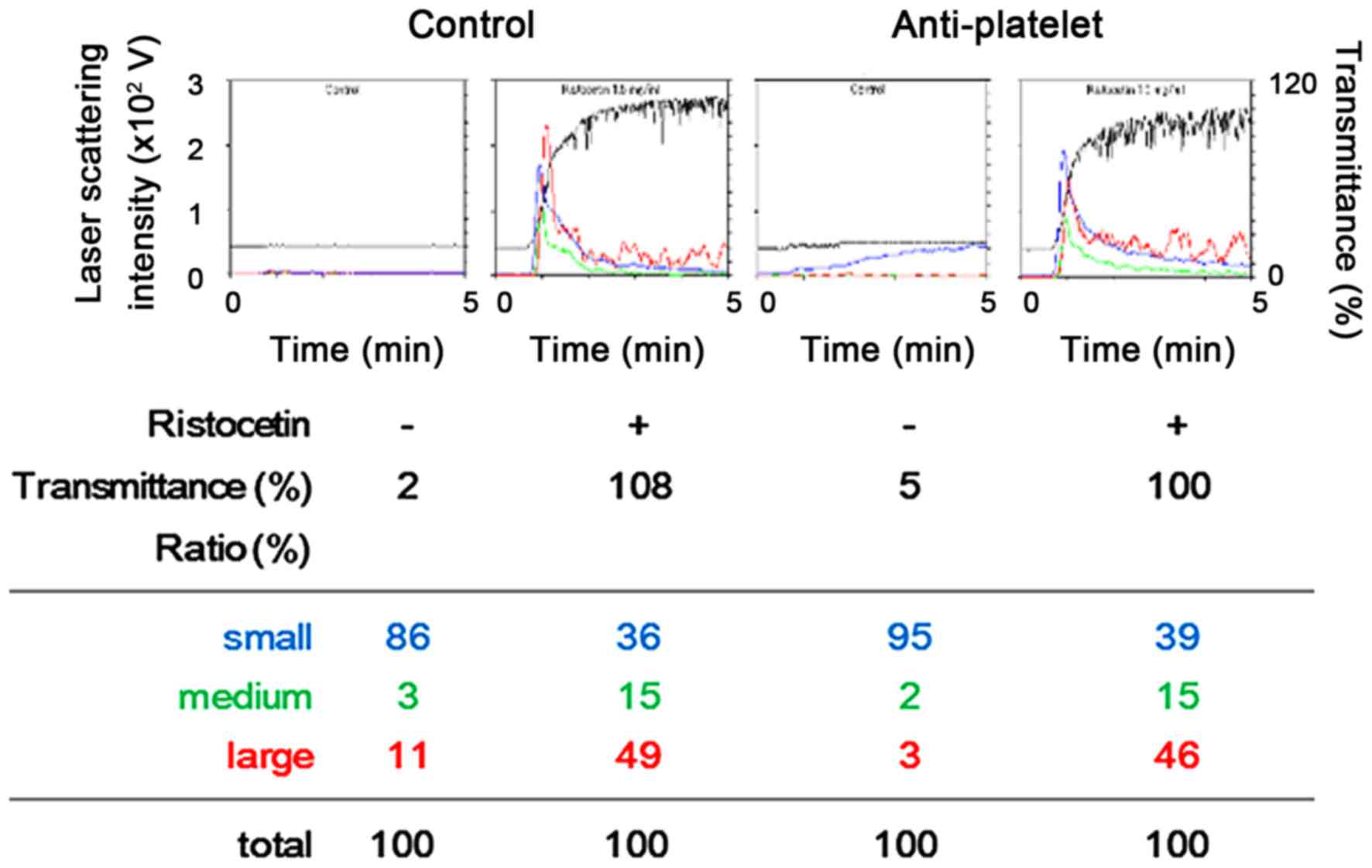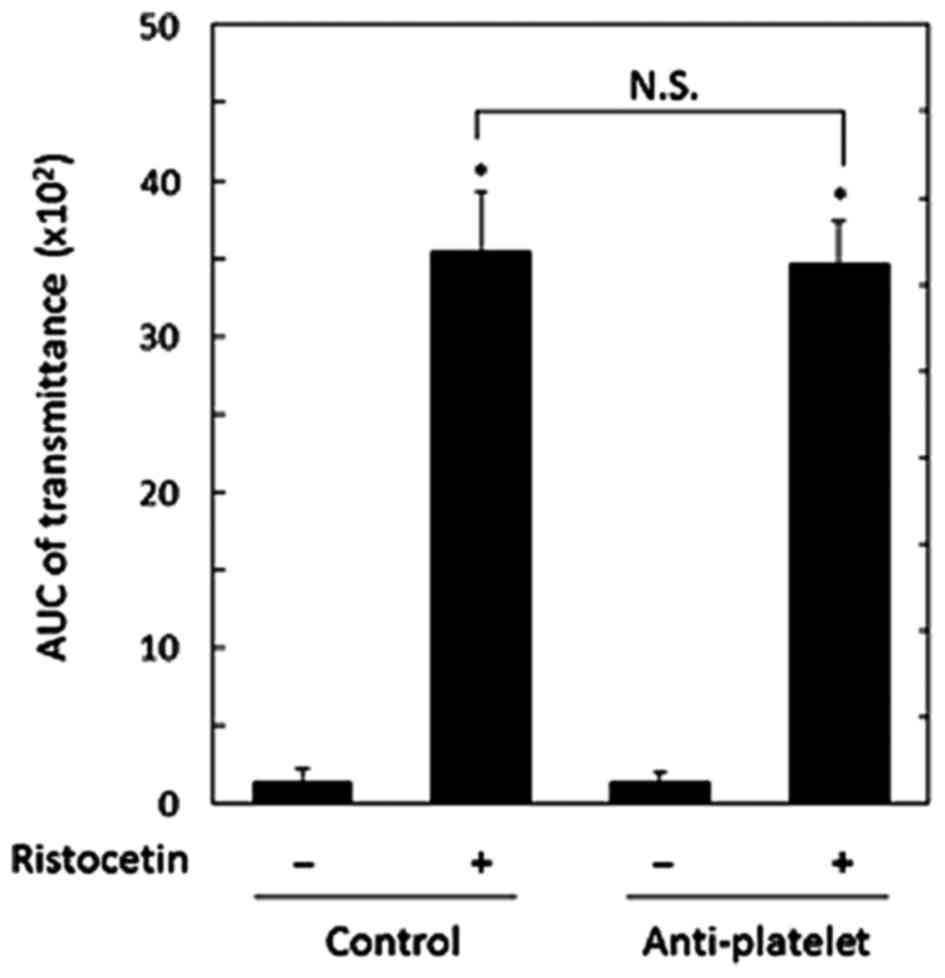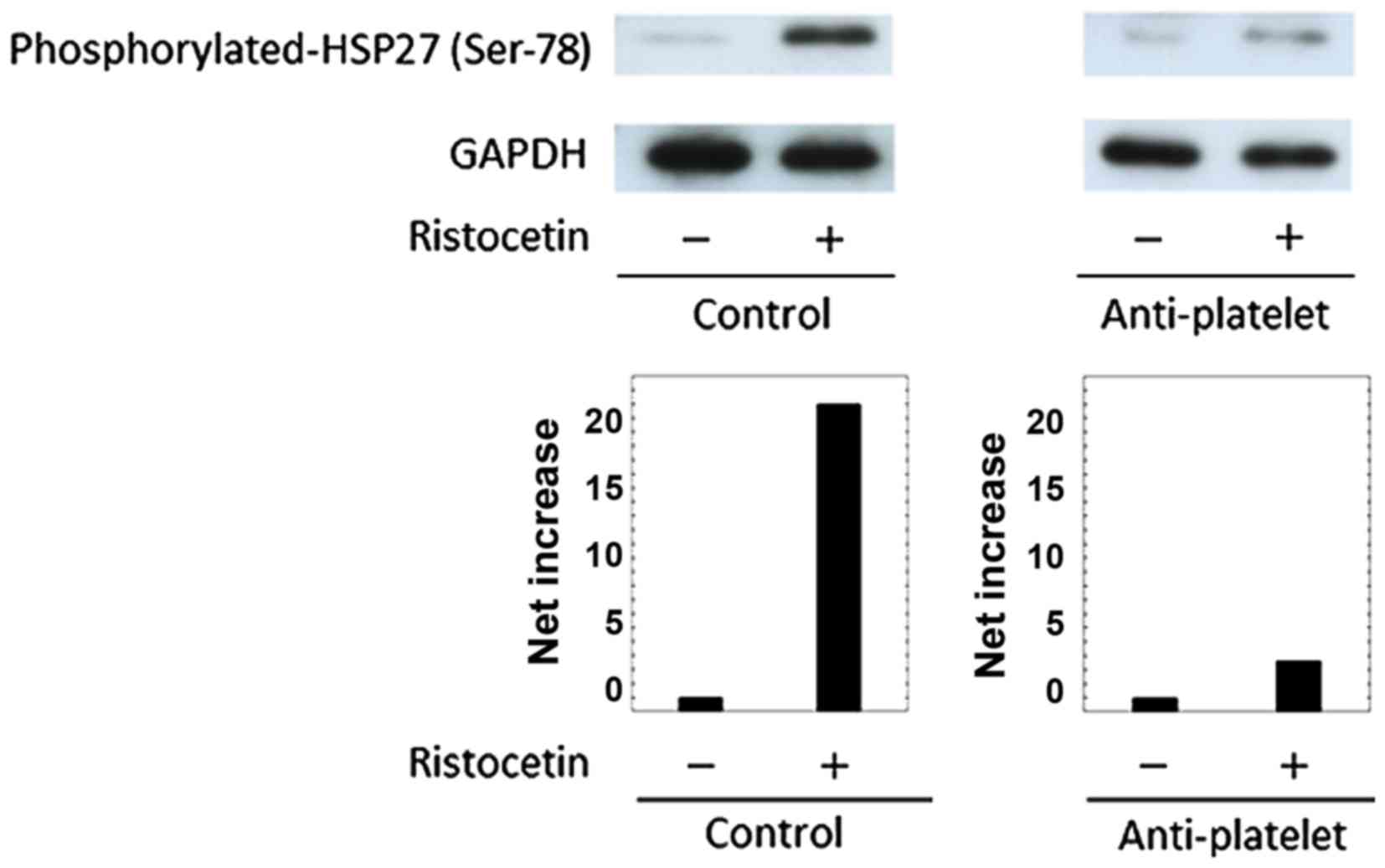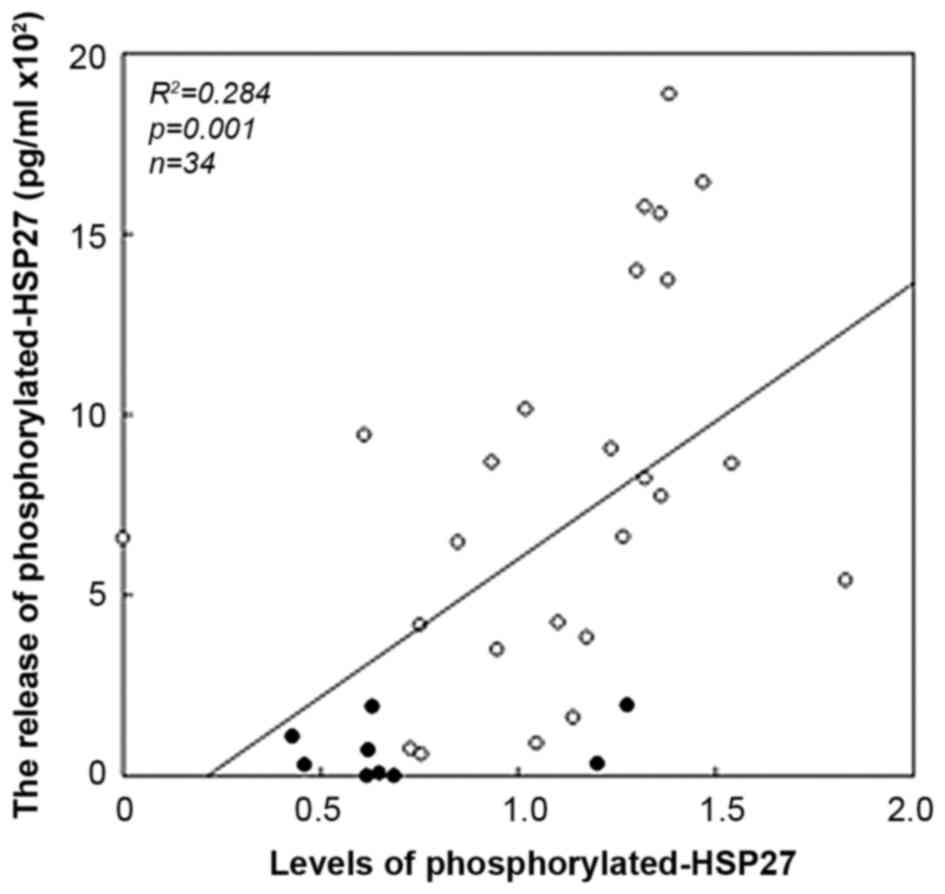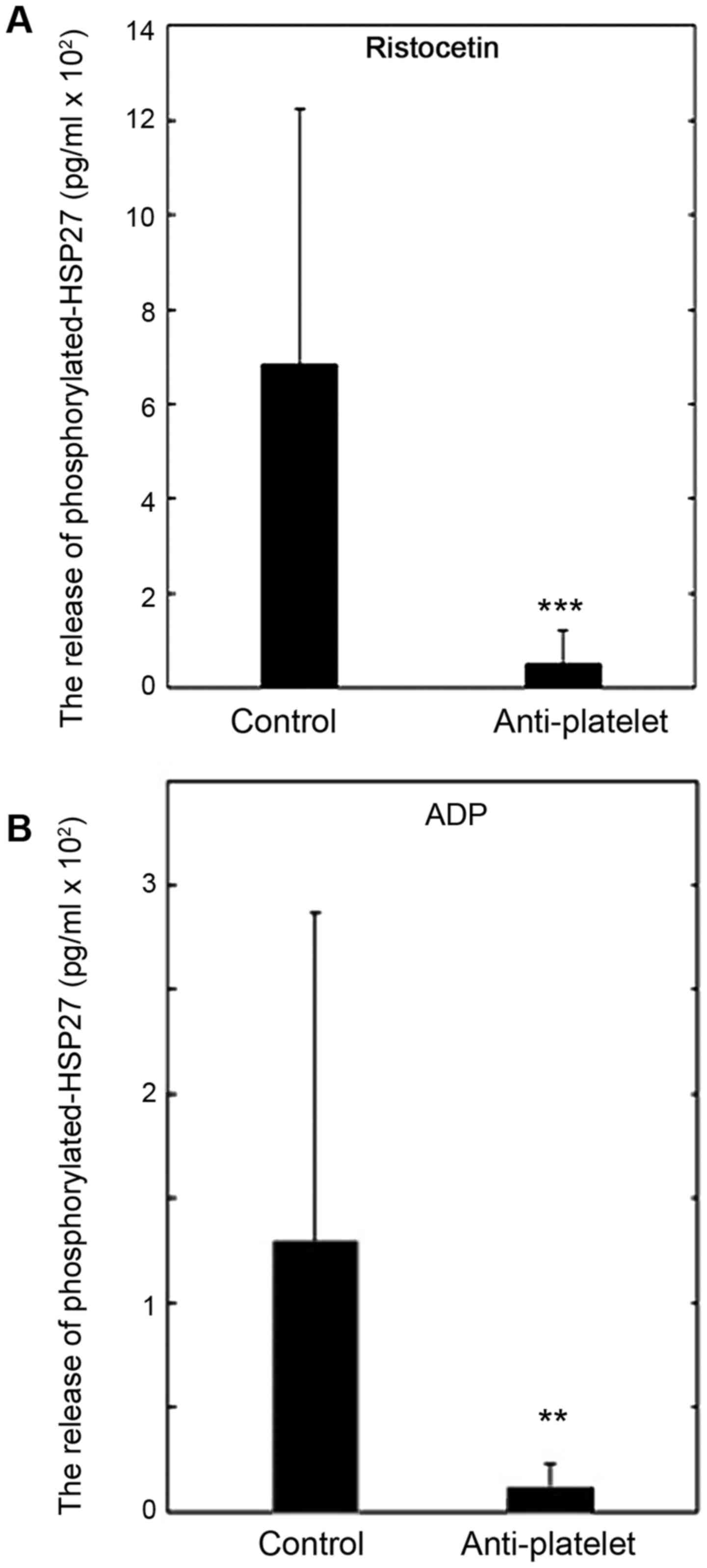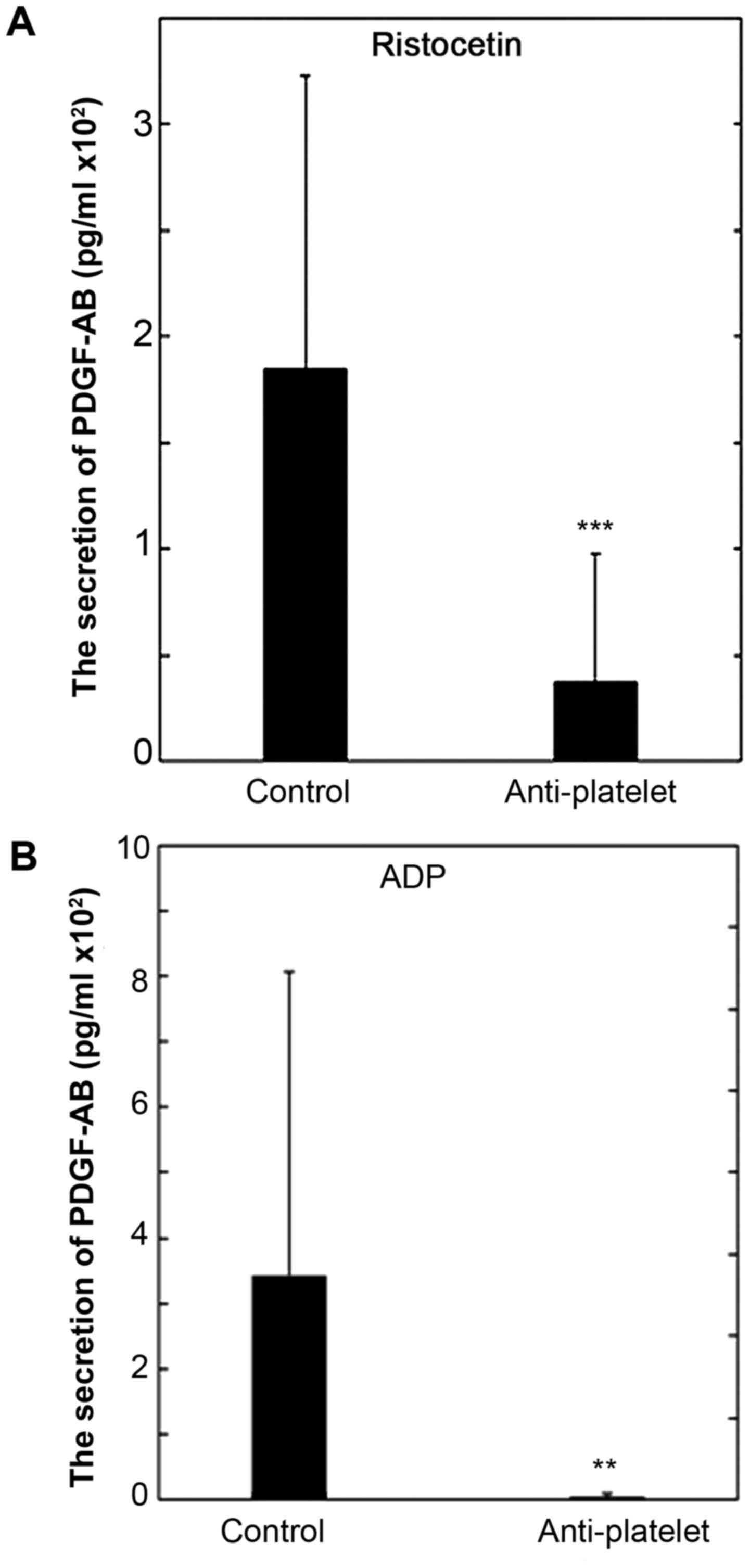|
1
|
Davì G and Patrono C: Platelet activation
and atherothrombosis. N Engl J Med. 357:2482–2494. 2007. View Article : Google Scholar : PubMed/NCBI
|
|
2
|
Furie B and Furie BC: Mechanisms of
thrombus formation. N Engl J Med. 359:938–949. 2008. View Article : Google Scholar : PubMed/NCBI
|
|
3
|
Berndt MC, Shen Y, Dopheide SM, Gardiner
EE and Andrews RK: The vascular biology of the glycoprotein Ib-IX–V
complex. Thromb Haemost. 86:178–188. 2001.PubMed/NCBI
|
|
4
|
Garcia A, Quinton TM, Dorsam RT and
Kunapuli SP: Src family kinase-mediated and Erk-mediated
thromboxane A2 generation are essential for VWF/GPIb-induced
fibrinogen receptor activation in human platelets. Blood.
106:3410–3414. 2005. View Article : Google Scholar : PubMed/NCBI
|
|
5
|
Dong JF, Berndt MC, Schade A, McIntire LV,
Andrews RK and López JA: Ristocetin-dependent, but not
botrocetin-dependent, binding of von Willebrand factor to the
platelet glycoprotein Ib-IX–V complex correlates with
shear-dependent interactions. Blood. 97:162–168. 2001. View Article : Google Scholar : PubMed/NCBI
|
|
6
|
Enomoto Y, Adachi S, Matsushima-Nishiwaki
R, Doi T, Niwa M, Akamatsu S, Tokuda H, Yoshimura S, Iwama T and
Kozawa O: Thromboxane A2 promotes soluble CD40 ligand release from
platelets in atherosclerotic patients. Athelosclerosis.
209:415–421. 2010. View Article : Google Scholar
|
|
7
|
Zimmet P, Alberti KG and Shaw J: Global
and societal implications of the diabetes epidemic. Nature.
414:782–787. 2001. View
Article : Google Scholar : PubMed/NCBI
|
|
8
|
Grundy SM, Benjamin IJ, Burke GL, Chait A,
Eckel RH, Howard BV, Mitch W, Smith SC Jr and Sowers JR: Diabetes
and cardiovascular disease: A statement for healthcare
professionals from the American Heart Association. Circulation.
100:1134–1146. 1999. View Article : Google Scholar : PubMed/NCBI
|
|
9
|
Matsuno H, Tokuda H, Ishisaki A, Zhou Y,
Kitajima Y and Kozawa O: P2Y12 receptors play a significant role in
the development of platelet microaggregation in patients with
diabetes. J Clin Endocrinol Metab. 90:920–927. 2005. View Article : Google Scholar : PubMed/NCBI
|
|
10
|
Hanai Y, Adachi S, Yasuda I, Takai S,
Matsushima-Nishiwaki R, Kato H, Enomoto Y, Akamatsu S, Sakakibara
S, Ogura S, et al: Collagen-induced p38 MAP kinase activation is a
biomarker of platelet hyper-aggregation in patients with diabetes
mellitus. Life Sci. 85:386–394. 2009. View Article : Google Scholar : PubMed/NCBI
|
|
11
|
Colwell JA; American Diabetes Association,
: Aspirin therapy in diabetes. Diabetes Care. 26 Suppl 1:S87–S88.
2003. View Article : Google Scholar : PubMed/NCBI
|
|
12
|
Hankey GJ and Eikelboom JW: Aspirin
resistance. Lancet. 367:606–617. 2006. View Article : Google Scholar : PubMed/NCBI
|
|
13
|
Mymrikov EV, Seit-Nebi AS and Gusev NB:
Large potentials of small heat shock proteins. Physiol Rev.
91:1123–1159. 2011. View Article : Google Scholar : PubMed/NCBI
|
|
14
|
Bruey JM, Ducasse C, Bonniaud P, Ravagnan
L, Susin SA, Diaz-Latoud C, Gurbuxani S, Arrigo AP, Kroemer G,
Solary E, et al: Hsp27 negatively regulates cell death by
interacting with cytochrome c. Nat Cell Biol. 2:645–652. 2000.
View Article : Google Scholar : PubMed/NCBI
|
|
15
|
Arrigo AP: The cellular ‘networking’ of
mammalian Hsp27 and its functions in the control of protein
folding, redox state and apoptosis. Adv Exp Med Biol. 594:14–26.
2007. View Article : Google Scholar : PubMed/NCBI
|
|
16
|
Pockley AG: Heat shock proteins,
inflammation, and cardiovascular disease. Circulation.
105:1012–1017. 2002. View Article : Google Scholar : PubMed/NCBI
|
|
17
|
Landry J, Lambert H, Zhou M, Lavoie JN,
Hickey E, Weber LA and Anderson CW: Human HSP27 is phosphorylated
at serines 78 and 82 by heat shock and mitogen-activated kinases
that recognize the same amino acid motif as S6 kinase II. J Biol
Chem. 267:794–803. 1992.PubMed/NCBI
|
|
18
|
Acunzo J, Katsogiannou M and Rocchi P:
Small heat shock proteins HSP27 (HspB1), αB-crystallin (HspB5) and
HSP22 (HspB8) as regulators of cell death. Int J Biochem Cell Biol.
44:1622–1631. 2012. View Article : Google Scholar : PubMed/NCBI
|
|
19
|
Saklatvala J, Rawlinson L, Waller RJ,
Sarsfield S, Lee JC, Morton LF, Barnes MJ and Farndale RW: Role for
p38 mitogen-activated protein kinase in platelet aggregation caused
by collagen or a thromboxane analogue. J Biol Chem. 271:6586–6589.
1996. View Article : Google Scholar : PubMed/NCBI
|
|
20
|
Kageyama Y, Doi T, Akamatsu S, Kuroyanagi
G, Kondo A, Mizutani J, Otsuka T, Tokuda H, Kozawa O and Ogura S:
Rac regulates collagen-induced HSP27 phosphorylation via p44/p42
MAP kinase in human platelets. Int J Mol Med. 32:813–818. 2013.
View Article : Google Scholar : PubMed/NCBI
|
|
21
|
Tokuda H, Kuroyanagi G, Tsujimoto M,
Enomoto Y, Matsushima-Nishiwaki R, Onuma T, Kojima A, Doi T, Tanabe
K, Akamatsu S, et al: Release of phosphorylated HSP27 (HSPB1) from
platelets is accompanied with the accerelation of aggregation in
diabetic patients. PLoS One. 10:e01289772015. View Article : Google Scholar : PubMed/NCBI
|
|
22
|
Tokuda H, Kuroyanagi G, Tsujimoto M,
Matsushima-Nishiwaki R, Akamatsu S, Enomoto Y, Iida H, Otsuka T,
Ogura S, Iwama T, et al: Thrombin receptor-activating protein
(TRAP)-activated Akt is involved in the release of
phosphorylated-HSP27 (HSPB1) from platelets in DM patients. Int J
Mol Sci. 17(pii): E7372016. View Article : Google Scholar : PubMed/NCBI
|
|
23
|
Reddy VS, Madala SK, Trinath J and Reddy
GB: Extracellular small heat shock proteins: exosomal biogenesis
and function. Cell Stress Chaperones. Oct 30–2017.(Epub ahead of
print). View Article : Google Scholar : PubMed/NCBI
|
|
24
|
Kato K, Ito H, Hasegawa K, Inaguma Y,
Kozawa O and Asano T: Modulation of the stress-induced synthesis of
hsp27 and alpha B-crystallin by cyclic AMP in C6 rat glioma cells.
J Neurochem. 66:946–950. 1996. View Article : Google Scholar : PubMed/NCBI
|
|
25
|
Laemmli UK: Cleavage of structural
proteins during the assembly of the head of bacteriophage T4.
Nature. 227:680–685. 1970. View
Article : Google Scholar : PubMed/NCBI
|
|
26
|
Liu J, Pestina TI, Berndt MC, Steward SA,
Jackson CW and Gartner TK: The roles of ADP and TXA in
botrocetin/VWF-induced aggregation of washed platelets. J Thromb
Haemost. 2:2213–2222. 2004. View Article : Google Scholar : PubMed/NCBI
|
|
27
|
Kato H, Takai S, Matsushima-Nishiwaki R,
Adachi S, Minamitani C, Otsuka T, Tokuda H, Akamatsu S, Doi T,
Ogura S, et al: HSP27 phosphorylation is correlated with
ADP-induced platelet granule secretion. Arch Biochem Biophys.
475:80–86. 2008. View Article : Google Scholar : PubMed/NCBI
|
|
28
|
Rayner K, Chen YX, McNulty M, Simard T,
Zhao X, Wells DJ, de Belleroche J and O'Brien ER: Extracellular
release of the atheroprotective heat shock protein 27 is mediated
by estrogen and competitively inhibits acLDL binding to scavenger
receptor-A. Circ Res. 103:133–141. 2008. View Article : Google Scholar : PubMed/NCBI
|
|
29
|
Thuringer D, Jego G, Wettstein G, Terrier
O, Cronier L, Yousfi N, Hébrard S, Bouchot A, Hazoumé A, Joly AL,
et al: Extracellular HSP27 mediates angiogenesis through Toll-like
receptor 3. FASEB J. 27:4169–4183. 2013. View Article : Google Scholar : PubMed/NCBI
|
|
30
|
Salari S, Seibert T, Chen YX, Hu T, Shi C,
Zhao X, Cuerrier CM, Raizman JE and O'Brien ER: Extracellular HSP27
acts as a signaling molecule to activate NF-κB in macrophages. Cell
Stress Chaperones. 18:53–63. 2013. View Article : Google Scholar : PubMed/NCBI
|
|
31
|
Jin C, Cleveland JC, Ao L, Li J, Zeng Q,
Fullerton DA and Meng X: Human myocardium releases heat shock
protein 27 (HSP27) after global ischemia: The proinflammatory
effect of extracellular HSP27 through toll-like receptor (TLR)-2
and TLR4. Mol Med. 20:280–289. 2014. View Article : Google Scholar : PubMed/NCBI
|



